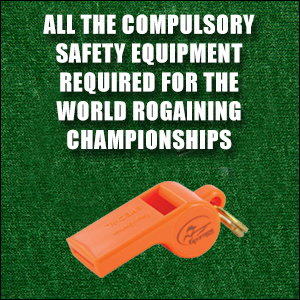
How many Rogaining rules actually relate to safety?
The Preamble to the Rules states "Many of the competition rules relate to safety" - in fact there are only 7 out of the 33 rules which relate to safety in any way - and those seven rules are paraphrased below.
- Rule #1 - Travel in a team
- Rule #2 - Teams with kids have to have an adult
- Rule #10 - Team members must stay within earshot
- Rule #15 - Everyone must carry a whistle
- Rule #19 - Teams must fill in an "intention sheet"
- Rule #32 - Everyone must respond to a distress signal
- Rule #33 - You may carry mobile phones for safety purposes
Compulsory Safety Equipment
Rule #15 in both the Australian Rules of Rogaining and the International Rogaining Federation Rules of Rogaining states "Competitors shall carry a whistle at all times whilst on the course." There is no other compulsory safety equipment required.
This means that -
- Space blankets are not compulsory
- Snake bandages are not compulsory
- Personal Locator Beacons are not compulsory
- First Aid Kits are not compulsory
If a whistle is the only piece of compulsory safety equipment required by rogainers under the rules, how dangerous can rogaining be?
In rogaines in the 1970s, safety was a big concern
When the sport of Rogaining was invented in the mid 1970s, the world was a different place. Technologies that we take for granted today were in their infancy - there were no mobile phones, no satellite phones, no Global Positioning System; no Personal Locator Beacons, and no emergency helicopter rescue services. For safety reasons, in the past it actually made sense to make Rogaining a team sport.
Rogaines today are much, much safer
It is just as easy to get into trouble on a rogaine today as it was when Rogaining was invented - but the chances of a quicker rescue and a more favourable outcome are much greater today because of the advances in technology mentioned above.
Personal Locator Beacons (PLBs)
Solo Rogaining should be allowed only if PLBs are compulsory for each solo competitor. A solo rogainer with a PLB is arguably at less risk than members of a two-person team who have no PLB. A solo rogainer who gets into serious trouble and immediately activates a PLB is likely to be rescued much sooner than a member of a team who gets into serious trouble where the second team member has to leave his partner (alone) and make his way (alone) to a Hash House or All Night Cafe to raise an alarm.
Indeed, that second rogainer who goes for help is more at risk than a solo rogainer, because that second rogainer does not have a PLB. There is also a greater urgency for the second rogainer to travel as fast as they can to raise the alarm, which adds to the risk. If the second rogainer gets into serious trouble while they are on their mercy dash, they are really in trouble!
Worst Case Scenarios
Of course, a solo rogainer who gets into trouble cannot activate a PLB if he or she is unconscious. There is always the possibility of head trauma through falling, getting hit by falling rocks or branches, or even running into a tree in the dark. There is also the possibility of hypothermia and heat exhaustion that can render rogainers unable to set off a PLB, and there is also the possibility of heart attack and stroke, especially for all the Veterans, Super Veterans and Ultra Veterans out there!
However, in a team of two, if one person is unconscious, the second team member will not be able to go for help as they have to stay with the victim. They don't have a PLB; they can't go for help; all they can do is blow a whistle and hope somebody responds!
PLBs dramatically reduce the risks involved in the sport of Rogaining. We believe that if Solo Rogaining is allowed, PLBs must be compulsory for solo rogainers. They probably should be made compulsory for teams as well ...
Life is a Risk
There is probably more risk of injury or death when travelling to a rogaine than there is during the event, and there is definitely a greater risk of injury or death when driving home afterwards, especially if a rogainer is driving!
Assuming solo rogainers are required to carry a PLB, is the risk of injury or death larger or smaller if we rogaine solo? Solo rogainers are obviously more at risk if they are unable to activate their PLB, but it could also be argued that they are less at risk in situations where they can activate a PLB - such as a broken leg or a snake bite.
Risk Waivers
All rogainers are already required to sign a risk waiver prior to each event. We acknowledge that the sport of Rogaining involves considerable risk. We agree that by entering the rogaine we do so at our own risk. Risk waivers also state that the relevant Rogaining association does not accept any responsibility for death, injury, loss or damage to the participant. Rogaine organizers who allow solo entries in the future would be just as safe from litigation then as they are now.
(Next Page)
|




|






